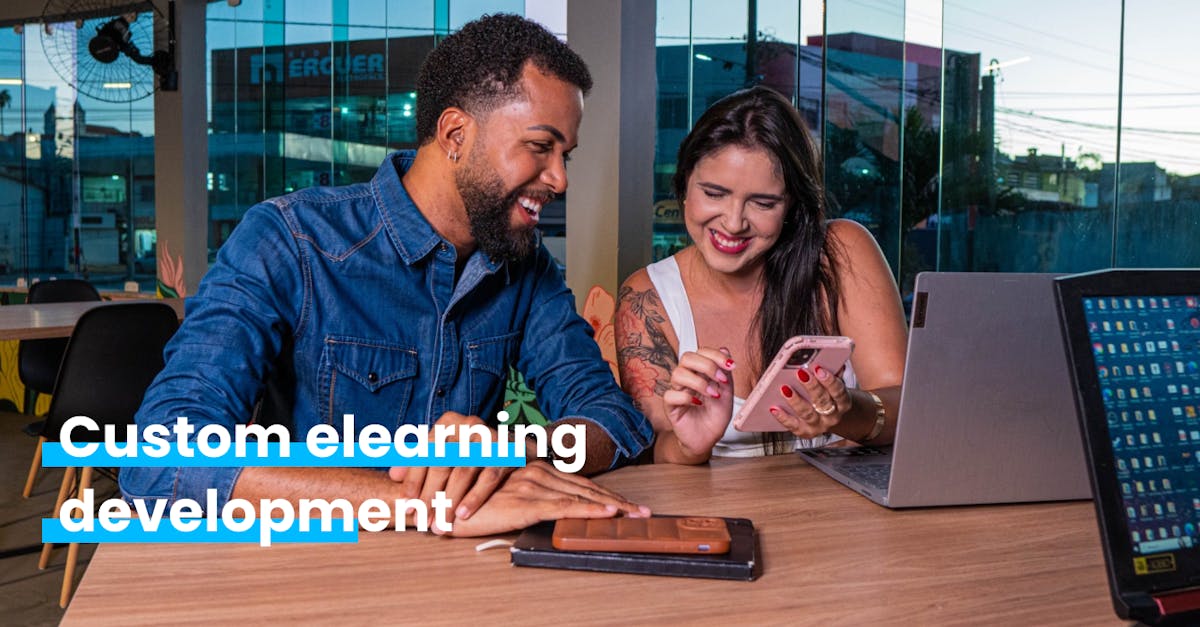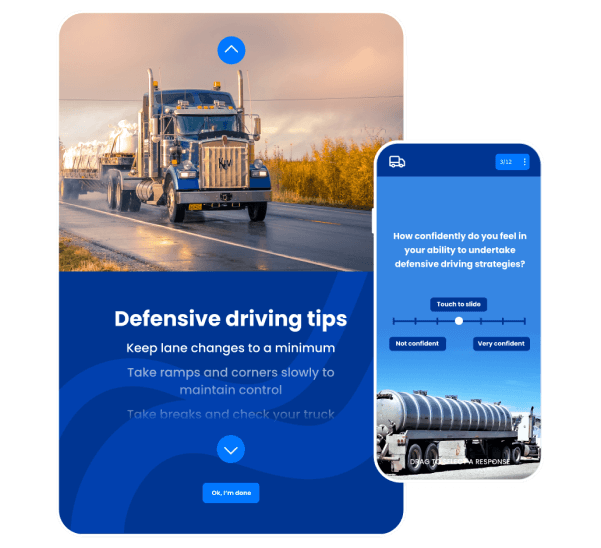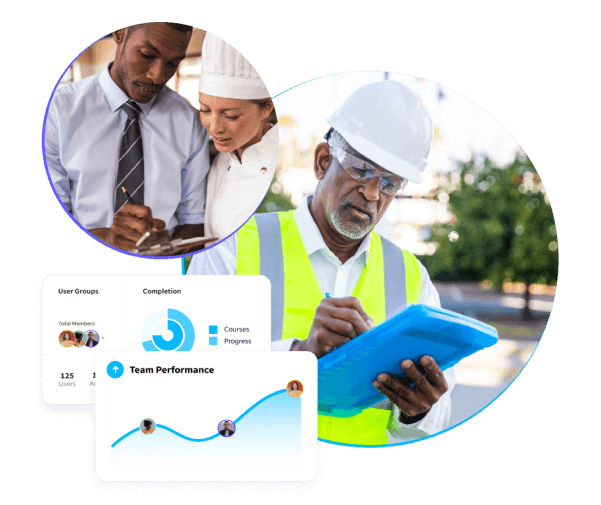Custom elearning development: benefits, process, challenges, solutions, trends

In the realm of personalized learning, innovation meets education to create a transformative experience for learners and organizations alike. Custom elearning development becomes a dynamic approach that goes beyond one-size-fits-all training programs.
As organizations strive to meet the unique needs of their workforce and learners, the role of custom eLearning development becomes increasingly vital.
This article explores the world of custom elearning, delving into its key benefits, the development process, and the challenges faced by organizations seeking to revolutionize their training methods.
What is Custom Elearning Development?
Custom eLearning development refers to the creation of tailored digital learning experiences designed to meet the specific needs and requirements of learners or organizations.

In contrast to off-the-shelf solutions, custom eLearning development involves the customization of content, instructional design, and interactive elements to satisfy learners’ unique needs.
This approach is gaining increasing importance in training and education as it allows for a more targeted and engaging learning experience. It fosters better retention and application of knowledge.
The growing demand for custom elearning reflects the recognition that generic training materials often fall short in addressing the diverse learning styles, industry-specific nuances, and evolving skill requirements in today's dynamic educational landscape.
You can discover unparalleled possibilities in custom elearning development with EdApp—a cutting-edge platform designed to revolutionize the way you create and deliver training programs.

EdApp combines intuitive design, adaptive learning paths, rich multimedia integration, and robust analytics for a seamless and efficient training solution.

With a commitment to time and cost efficiency, mobile accessibility, and dedicated customer support, EdApp empowers you to elevate your training initiatives. With this app, you can engage your learners with personalized, interactive, and impactful educational experiences.
Experience the future of elearning development – sign up to EdApp and transform your training content into a dynamic, effective, and unparalleled learning journey.
Key Benefits of Custom Elearning
If you’re thinking of adopting custom elearning design for your organization, you should know all about its key benefits.

Tailored Content to Specific Needs
Custom elearning development excels in tailoring content to the specific needs of learners and organizations. It allows for a detailed analysis of the target audience, making sure that the content addresses the unique goals and challenges of learners.
This personalized approach enhances the effectiveness of the learning experience, as it directly aligns with the knowledge gaps and requirements of the individuals or groups involved.
Enhanced Engagement and Interactivity
One of the standout advantages of custom eLearning lies in its ability to foster enhanced engagement and interactivity. Through the incorporation of interactive elements such as quizzes, simulations, and multimedia, learners become actively involved in the process.
This hands-on approach not only keeps learners more engaged but also facilitates better retention of information. Custom elearning development services are designed to accommodate various learning styles.
This guarantees a dynamic and interactive environment that caters to the diverse preferences of different types of learners.
Flexibility and Adaptability
Custom elearning solutions offer unparalleled flexibility and adaptability, allowing organizations to respond swiftly to changing training needs.
Whether it's updating content to reflect industry changes, incorporating new technologies, or addressing evolving skill requirements, custom elearning software can be easily adapted to meet these challenges.
This adaptability makes the learning materials remain relevant and effective over time, offering a sustainable solution for organizations seeking to future-proof their training programs.
Cost-Effectiveness in the Long Run
While the initial investment in custom elearning development may seem higher than other alternatives, its long-term cost-effectiveness is a compelling factor.
Tailoring content to specific needs reduces the likelihood of unnecessary or irrelevant training, improving the use of resources. Plus, the adaptability of custom elearning means that updates and modifications can be made without significant recurring costs.
Over time, this tailored approach proves cost-effective, as you can benefit from a more efficient, targeted, and sustainable training solution that aligns precisely with your unique requirements.
So, what are the steps in the custom elearning development process?
Understanding the Custom Elearning Development Process
Understanding and executing the steps in the custom elearning development process guarantees the creation of a tailored, engaging, and effective learning experience. This will surely meet the unique requirements of your organization and learners.

Identifying Learning Objectives
The custom elearning development process begins with a thorough identification of learning objectives. This involves a detailed examination of what knowledge and skills need to be trained.
Clear learning objectives serve as the foundation for the entire development process, guiding elearning content authoring and making sure that the training meets its intended goals.
Analyzing Target Audience
Understanding the characteristics, preferences, and proficiency levels of learners is also crucial. Analyzing their demographic and psychographic aspects helps in tailoring the content to be relevant and engaging for them.
This analysis guarantees that the elearning program resonates with the learners, enhancing its overall effectiveness.
Creating Customized Learning Paths
Custom elearning involves designing personalized learning paths that align with the identified objectives and the diverse needs of learners
This includes structuring the content in a logical sequence, considering different learning styles, and accommodating varying levels of expertise within the target audience.
Customized learning paths promote a more inclusive learning experience, which also makes it more efficient and effective.
Incorporating Interactive Elements
To enhance engagement and facilitate better retention, interactive elements such as quizzes, simulations, case studies, and multimedia are integrated into the content.
This step goes beyond traditional learning materials, creating a dynamic and participatory learning environment.
Incorporating interactive elements makes sure that learners are actively involved in the learning process, leading to a more immersive experience.
Choosing the Right Technology
Choosing the right technology is a critical aspect of implementing custom elearning. This involves selecting an eLearning platform or system that aligns with the specific needs of your organization and the characteristics of your learners.
Factors such as user interface, scalability, and compatibility with existing systems are carefully considered during this stage.
Guaranteeing Accessibility and Compatibility
Custom eLearning must be accessible to all learners, including those with diverse needs. Making sure that the content is compatible with different devices, browsers, and accessibility tools is essential.
This step involves testing the elearning training courses across various platforms to guarantee a seamless and inclusive learning experience for all users.
Challenges and Solutions in Custom Elearning Development
Despite all of its advantages, custom elearning development also has its challenges. Successfully navigating these challenges and implementing the suggested solutions contribute to the seamless development of custom elearning content.

By efficiently managing time and resources, fostering collaboration, guaranteeing consistent quality, and prioritizing maintenance, you can create and maintain effective, high-quality elearning experiences for your learners.
Limited Time and Resources
One of the primary challenges in custom eLearning development is managing time and resources effectively. Efficient project management strategies can help streamline the development process.
Breaking down the project into manageable sprints, setting realistic timelines, and prioritizing tasks make sure that the development team can work systematically.
This minimizes delays and enhances productivity, guaranteeing that resources are well-managed and the project is finished within the desired schedule.
Geographically Dispersed Teams
Addressing time constraints requires seamless collaboration among team members, especially if they are dispersed geographically.
Using collaboration and communication tools, such as project management software, video conferencing, and messaging platforms, enhances real-time communication and fosters collaboration.
These tools allow effective coordination, feedback exchange, and transparent communication throughout the development cycle.
Consistent Quality Maintenance
Maintaining consistent quality in custom elearning content is a challenge that can be addressed through continuous testing and feedback loops.
Implementing regular quality assurance measures, including beta testing with representative users and soliciting feedback from stakeholders, allows for the identification of issues early in the development process.
This way, they are also solved immediately. This approach makes sure that the final product meets high-quality standards.
Evolving Learning and Organizational Needs
For the longevity and relevance of custom elearning content, regular updates and maintenance are essential. This involves monitoring industry changes, technology advancements, and learner feedback to identify areas that need improvement or modification.
Implementing a structured plan for routine updates and maintenance guarantees that the content remains accurate, up-to-date, and aligned with evolving learning and organizational needs.
Future Trends in Custom Elearning Development
The integration of artificial intelligence (AI) for personalized learning experiences and adaptive content delivery marks future trends in custom elearning development.

The incorporation of virtual and augmented reality applications also promises to transform elearning into a more immersive and interactive domain. This will redefine how users engage with learning content.
Embracing these trends will empower your organization to stay at the forefront of effective and innovative learning solutions.
Integration of Artificial Intelligence
The future of custom eLearning development is poised to witness a significant shift with the integration of AI.
AI technologies, such as machine learning and natural language processing, can enhance the learning experience by personalizing content recommendations, automating assessments, and giving intelligent feedback.
Custom elearning platforms are using AI to analyze learner behavior, identify patterns, and adapt content delivery to individual needs, creating a more dynamic and tailored learning experience.
This trend improves engagement and allows organizations to deliver more efficient and targeted training programs.
Personalization and Adaptive Learning
The future landscape of custom elearning development is characterized by a strong emphasis on personalization and adaptive learning.
Customized learning paths, tailored content, and individualized assessments will become more sophisticated through the use of data-driven insights and AI algorithms.
Adaptive learning systems will dynamically adjust the difficulty and pace of content delivery based on each learner's progress and preferences.
This personalization makes sure that learners receive content that aligns precisely with their skill levels, learning styles, and goals, fostering a more effective and engaging learning experience.
Virtual and Augmented Reality Applications
The incorporation of virtual and augmented reality (VR/AR) applications is also set to revolutionize custom elearning development
VR/AR technologies create immersive learning environments, allowing learners to engage with content in a more interactive and realistic manner. Custom eLearning modules can simulate real-world scenarios, giving learners hands-on experience and enhancing their skill acquisition.
Whether it's virtual workplace simulations, augmented reality overlays for on-the-job training, or immersive educational experiences, this integration offers a futuristic approach that significantly enhances learner engagement and knowledge retention.
Author
Donna Dane
Donna is an elearning content writer for EdApp, a mobile-based microlearning platform designed for today's digital training needs. When she's not writing web articles, she writes lines of code or songs or anything food-related.
